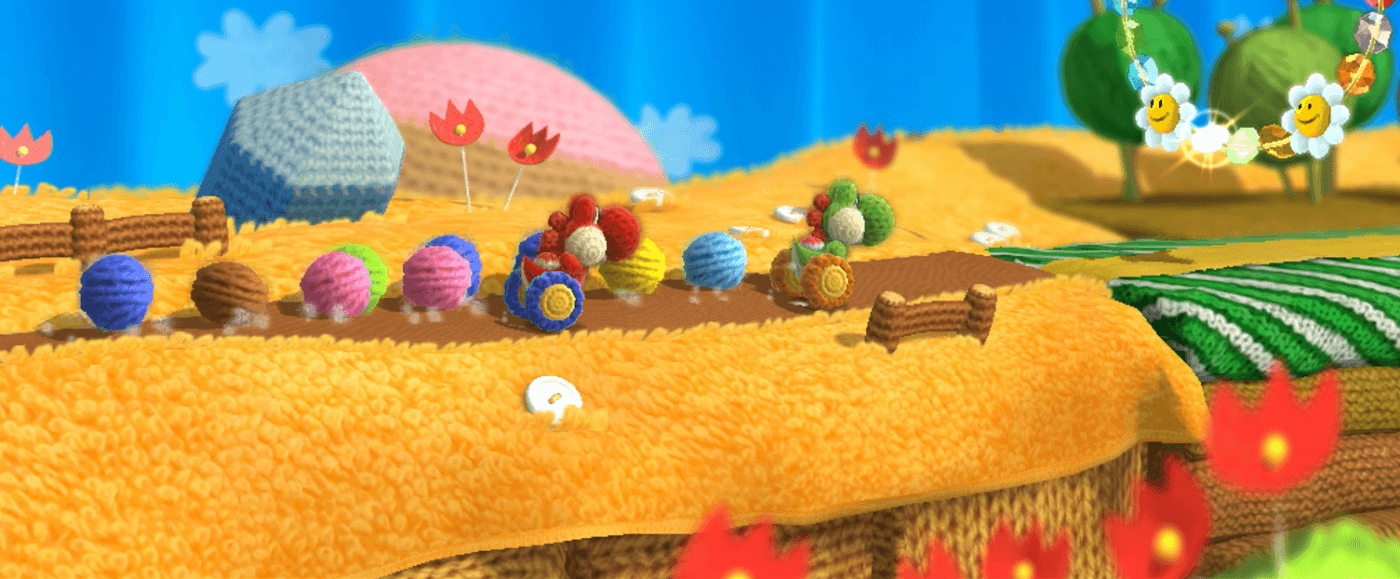Crafting Yoshi’s Worlds: Their Aesthetics Through The Years
Yoshi is back with another new game, and it’s one of his most beautiful yet. To mark the release of Yoshi’s Crafted World, let’s take a look at some of the other visual treats in Yoshi’s back catalogue.
Yoshi first made an appearance in 1990, a dinosaur steed for Mario to ride in Super Mario World. Shigeru Miyamoto had the idea around the time of Super Mario Bros 3, but the NES didn’t have the power to make Yoshi work – he would have to wait for the SNES. The character, who could eat enemies with his long sticky tongue, was extremely popular with audiences eventually leading to Nintendo giving him his own critically-adored game (technically Mario & Yoshi and Yoshi’s Cookie came first, but neither are particularly memorable).
Yoshi’s Island (Super Mario World 2 outside of Japan) was released in 1995, and saw Yoshi tasked with protecting Baby Mario. The biggest SNES release of the time was Donkey Kong Country, a side-scroller which used pre-rendered 3D graphics to create the impression of depth and fluid character movements. Yoshi’s Island was allegedly imagined, stylistically, as a contrast, even if it draws on the same game engine (although it did use the new Super FX2 enhancement to create special effects, like the screen psychedelically warping). The game looks as if it was drawn by crayon, full of bright colours and simple but well-crafted designs. A beautiful aesthetic that still looks good more than 20 years later.
The new visual style was once again praised
A sequel, Yoshi’s Story, appeared on the Nintendo 64 in 1998, and received a positive reception (although not quite as strong as its predecessor). You controlled one of six different coloured Yoshis, eating lots of fruit and solving puzzles. The game scrapped the crayon-drawing look of the original – instead taking place within a pop-up storybook, using 3D graphics to illustrate worlds crafted from various materials, such as cardboards and fabrics. Despite critics saying that it wasn’t very innovative, the new visual style was once again praised. A number of new Yoshi games trickled through, many of which were linked to Nintendo exhibiting its technology. Yoshi’s Safari (1993, SNES) cast you as Mario, riding around on Yoshi’s back shooting enemies with the Super Scope – the game struggled due to poor Super Scope sales. Yoshi’s Universal Gravitation (2005, Game Boy Advance) used a built-in tilt sensor to manipulate the game’s environment, however the sensor wasn’t good at picking up tilts. And then there was Yoshi’s Touch & Go (2005, Nintendo DS). Initially designed as a tech demo to demonstrate the DS’ power – players used the stylus, dual screens and microphone to help automatically moving characters through an obstacle course. It was well received but criticised for its short length.
Both games relied on an art style that had worked before
Other Yoshi’s Island games began to appear – a DS version (2006) functioned as a direct sequel, putting Yoshi in charge of saving every baby in the Mushroom Kingdom. A 3DS version (2014) offered essentially the same gameplay as the original. Both games relied on an art style that had worked before and were appreciated for their familiarity, if not their novelty. Fortunately, Yoshi fans only needed to wait one more year for a fresh take on the dinosaur.
Yoshi’s Woolly World was released for the Wii U in 2015, and it was another stunning game. Made entirely out of yarn and cloth, the gameplay had not changed much, but the visuals were beautiful. There were some new additions tied into the yarn aesthetic (Yoshi produced balls of yarn rather than eggs, which could tie up enemies or sew up bits of the platform). The game was not that challenging, but you’re playing for its cuteness and art design.
The Yoshi games aren’t where you’d turn for a tough challenge
Which leads us to the recent release of Yoshi’s Crafted World on the Switch. Again, the focus of the game is on its style, everything resembles cardboard cut-outs. You have the ability to flip the stage, enabling you to see behind objects, so you can see the folds and bits of tape holding these structures together – it really generates a sense of cohesiveness, and it makes this Yoshi adventure another fun one. The Yoshi games aren’t where you’d turn for a tough challenge, but they often demonstrate a level of stylistic innovation that even Mario can’t match. They’re a feast for the eyes, and I look forward to seeing where the series goes next.

Comments